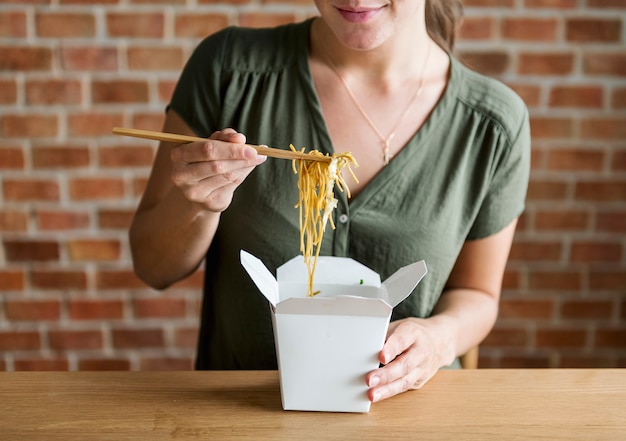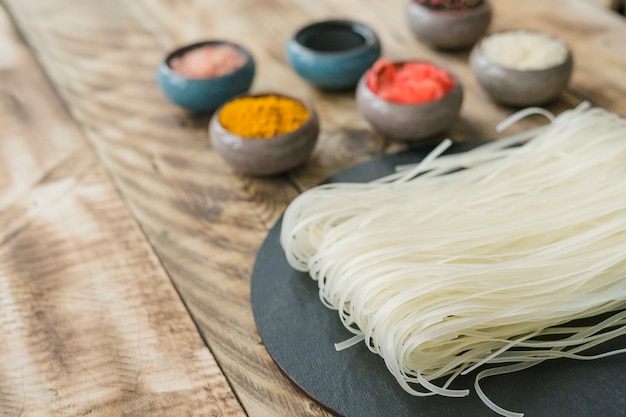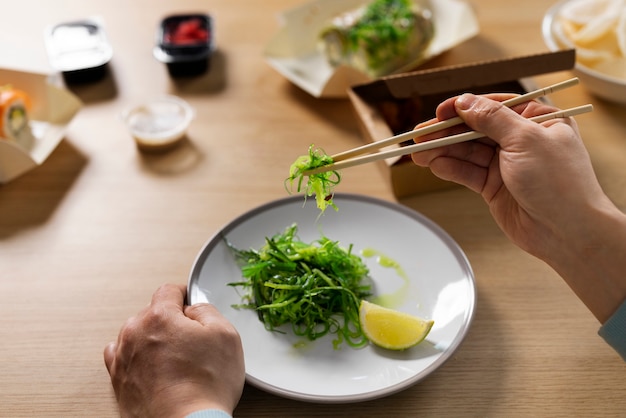Let's talk noodles, shall we? You know the drill: spaghetti, ramen, the usual suspects. But have you ever considered venturing into the world of soba noodles? These delightful Japanese noodles are a real game-changer. They're made from buckwheat, which gives them a distinctive nutty flavour and a slightly chewy texture. Honestly, once you try them, you'll wonder how you ever lived without them.
I first encountered soba noodles on a trip to Japan, and I was completely hooked. I loved their versatility – they could be simple or fancy, depending on the dish. Plus, they're packed with protein, fibre, and essential nutrients. It’s a win-win, really!
So, let's dive in and explore the wonderful world of soba noodles together!
(Part 1) The Lowdown on Soba Noodles

What are Soba Noodles?
Soba noodles are a traditional Japanese staple made from buckwheat flour. They're typically quite thin, with a slightly rough texture that helps them hold onto delicious sauces and toppings. You can find them in both white and brown varieties. Brown soba noodles are made from unrefined buckwheat flour, giving them a slightly stronger flavour and more pronounced texture.
Types of Soba Noodles: A Closer Look
There are actually a few different types of soba noodles, each with its own unique personality.
- 100% Soba: These noodles are made entirely from buckwheat flour, giving them that classic, earthy flavour. They're the most traditional and authentic type.
- Mori Soba: Mori soba is a blend of buckwheat flour and wheat flour. They have a smoother texture and a slightly milder flavour, which might appeal to those who aren't quite ready for the full buckwheat experience.
- Tsukemen: These are the thick, chewy noodles you'll often find served cold with a dipping sauce. They're a real treat for those who love a bit of texture in their meals.
- Kizami Soba: These noodles are chopped into small pieces, making them perfect for salads and soups.
The nutritional powerhouse: Why Soba Noodles are Good for You
Beyond their delicious flavour, soba noodles also boast a whole host of nutritional benefits.
- High in Fibre: Buckwheat is a fantastic source of dietary fibre, which aids in digestion and keeps you feeling full for longer.
- Gluten-Free: Traditional soba noodles are naturally gluten-free, making them a safe and tasty choice for those with celiac disease or gluten sensitivity.
- Rich in Protein: Soba noodles contain a decent amount of protein, making them a satisfying and filling meal.
- Packed with Vitamins and Minerals: Buckwheat is a good source of vitamins like B vitamins and manganese, as well as essential minerals like iron and magnesium.
(Part 2) Cooking Soba Noodles: A Step-by-Step Guide

Don’t be intimidated! Cooking soba noodles is incredibly simple. Follow these steps and you’ll be a soba-cooking pro in no time.
1. Gather your tools:
You’ll need a large pot for boiling water, a strainer or colander to drain the noodles, and a bowl to serve them in.
2. Prep your noodles:
Before you get cooking, give your soba noodles a quick rinse under cold water. This helps remove excess starch and prevents them from sticking together.
3. Boiling water is your friend:
Fill a large pot with enough water to cover the noodles comfortably. Add a generous amount of salt to the water; it will season the noodles and help them cook evenly. I always use about 1 tablespoon of salt per 4 cups of water.
4. Add the noodles:
Once the water is boiling, gently lower the soba noodles into the pot. Don’t overcrowd the pot; if you’re cooking a large batch, do it in two separate batches.
5. Cook to perfection:
Soba noodles cook quickly, so keep a close eye on them! They’ll usually be ready in 3-5 minutes. Aim for “al dente” – cooked through but still with a bit of bite.
6. Drain those noodles:
Use a strainer or colander to drain the noodles thoroughly.
7. Cold water rinse (optional):
Rinsing the noodles with cold water right after draining will stop the cooking process and prevent sticking. This is especially helpful if you’re not using the noodles right away.
8. Time to get creative:
Now comes the fun part – serving those delicious soba noodles. They can be used in all sorts of dishes, from simple stir-fries to elegant salads.
(Part 3) Mastering the Art of Soba Noodle Stir-Fries

Stir-fries are the ultimate comfort food, and soba noodles are the perfect base for all sorts of flavourful and quick stir-fries. Here’s what you need to know to create a stir-fry masterpiece:
Tips for Stir-Fry Success
- Keep it simple: Stir-fries are all about fresh ingredients and quick cooking. Don’t overcomplicate things.
- Prep ahead: Cut your veggies and prepare your sauce before you start cooking. This will ensure everything moves quickly and seamlessly.
- Hot and Fast: Use a large wok or skillet that’s super hot. This will ensure your veggies cook evenly and don't get soggy.
- Don’t Overcrowd the Pan: If you have a lot of ingredients, cook them in batches to prevent overcrowding and ensure they cook properly.
- Taste as you go: Stir-fries are all about balancing flavours. Taste your sauce as you’re cooking and adjust seasoning as needed.
A Classic Soba Noodle Stir-fry recipe
This is a simple and delicious recipe that’s perfect for weeknight dinners. It's also very adaptable; you can swap out the veggies and protein based on what you have on hand.
Yields: 2 servingsPrep Time: 15 minutesCook Time: 15 minutes
Ingredients:
- 1 package (8 ounces) soba noodles
- 1 tablespoon sesame oil
- 1/2 cup sliced onion
- 1 cup sliced bell pepper (any colour)
- 1 cup sliced mushrooms
- 1/2 cup shredded carrots
- 1/2 cup edamame (shelled)
- 1/2 cup cooked chicken or tofu
- 1/4 cup soy sauce
- 2 tablespoons rice vinegar
- 1 tablespoon honey
- 1 teaspoon grated ginger
- 1/2 teaspoon sesame seeds, for garnish
Instructions:
- Cook the soba noodles according to the package directions. Drain and rinse with cold water. Set aside.
- In a large wok or skillet, heat the sesame oil over medium-high heat. Add the onion, bell pepper, mushrooms, and carrots. Cook for about 5 minutes, stirring occasionally, until the vegetables are tender-crisp.
- Add the edamame and chicken or tofu to the pan and cook for another 2 minutes.
- In a small bowl, whisk together the soy sauce, rice vinegar, honey, and ginger. Pour the sauce over the vegetables and chicken or tofu and stir to combine.
- Add the cooked soba noodles to the pan and toss everything together to coat evenly. Cook for another 2-3 minutes, until the noodles are heated through.
- Serve immediately, garnished with sesame seeds.
(Part 4) Soba Noodle Salads: A Refreshing Twist
You might be thinking, "Salad? With noodles?" But trust me, soba noodle salads are surprisingly delicious and refreshing. Plus, they're a great way to get a hearty and healthy meal on the table quickly.
Tips for a Stellar Soba Noodle Salad
- Choose a flavorful dressing: A simple vinaigrette is always a good option, but you can also get creative with sesame dressings, peanut sauces, or even spicy sriracha mayo.
- Mix and match your toppings: Soba noodle salads are all about combining different textures and flavours. Don’t be afraid to experiment with different veggies, proteins, nuts, seeds, and herbs.
- Keep it cool: Soba noodle salads are best served cold or chilled. So, make sure to chill the noodles and toppings before assembling the salad.
A Summertime Soba Noodle Salad Recipe
This bright and colourful salad is perfect for warm weather. It’s light and refreshing but also satisfying and filling thanks to the noodles and protein.
Yields: 4 servingsPrep Time: 20 minutesCook Time: 10 minutes
Ingredients:
- 1 package (8 ounces) soba noodles
- 1/2 cup cooked shrimp or chicken
- 1 cup chopped cucumber
- 1/2 cup chopped bell pepper (any colour)
- 1/2 cup chopped red onion
- 1/4 cup chopped fresh cilantro
- 1/4 cup chopped peanuts
- For the Dressing:
- 1/4 cup soy sauce
- 1/4 cup rice vinegar
- 2 tablespoons honey
- 1 tablespoon sesame oil
- 1/2 teaspoon grated ginger
- 1/4 teaspoon red pepper flakes (optional)
Instructions:
- Cook the soba noodles according to the package directions. Drain and rinse with cold water. Set aside.
- In a large bowl, whisk together the dressing ingredients until well combined.
- Add the cooked noodles, shrimp or chicken, cucumber, bell pepper, red onion, cilantro, and peanuts to the bowl. Toss everything together until evenly coated with the dressing.
- Chill the salad for at least 30 minutes before serving.
(Part 5) Beyond the Basics: Creative Soba Noodle Dishes
Now that you've mastered the basics of soba noodles, it’s time to have some fun! Here are a few ideas for taking your soba noodle game to the next level:
Soba Noodle Soup: A Warm and Comforting Meal
Soba noodles are a perfect addition to soups. They soak up the broth and add a satisfyingly chewy texture. Here are a few ideas:
- Miso Soup: Combine soba noodles with a classic miso broth, tofu, seaweed, and scallions.
- chicken noodle soup: Give your chicken noodle soup an Asian twist by adding soba noodles, ginger, and soy sauce.
- Vegetable Noodle Soup: Make a hearty and healthy vegetable soup with soba noodles, carrots, celery, potatoes, and spinach.
Soba Noodle Salad: A Fresh and Flavorful Option
Soba noodles can also be the star of a salad. Try these variations:
- Asian-Inspired: Toss soba noodles with sesame dressing, shredded carrots, cucumbers, edamame, and chopped peanuts.
- Mediterranean Twist: Combine soba noodles with feta cheese, Kalamata olives, cherry tomatoes, red onion, and a lemon vinaigrette.
Soba Noodle Bowls: A Customizable Feast
Soba noodle bowls are a great way to create a complete and satisfying meal. Here are a few ideas:
- Teriyaki Bowl: Top cooked soba noodles with grilled chicken or tofu, teriyaki sauce, sliced avocado, and sesame seeds.
- Spicy Korean Bowl: Combine soba noodles with kimchi, gochujang sauce, sesame oil, and a fried egg.
- Thai Curry Bowl: Toss soba noodles with your favourite Thai curry, coconut milk, vegetables, and peanuts.
(Part 6) Finding Soba Noodles: Where to Shop
Soba noodles are becoming more and more popular, but you might not find them in every grocery store. Here’s where to look:
- Asian Grocery Stores: This is your best bet. They'll have a wide selection of soba noodles, both dry and fresh.
- Specialty Grocery Stores: Some larger grocery stores with international sections carry soba noodles.
- Online Retailers: If you can't find soba noodles locally, you can order them online from various retailers.
(Part 7) Storage Tips: Keeping Your Soba Noodles Fresh
Soba noodles can be stored for several months if you follow these tips:
- Dry Soba Noodles: Store dry soba noodles in an airtight container in a cool, dry place. They can last for up to 6 months.
- Cooked Soba Noodles: Cooked soba noodles can be stored in the refrigerator for up to 3 days. To prevent them from sticking, toss them with a bit of oil or soy sauce.
(Part 8) FAQ: Your Soba Noodle Questions Answered
1. Can I substitute other noodles for soba?
While you can certainly use other noodles in your recipes, they won't have the same flavour or texture as soba. If you're looking for a gluten-free alternative, rice noodles or mung bean noodles are good options. But for the authentic soba experience, stick with the real deal.
2. How do I know if soba noodles are cooked?
You'll know they're cooked when they’re no longer stiff and have a slight bite to them. You can also test them by tasting a small piece. They should be tender but not mushy.
3. What are some common toppings for soba noodles?
The possibilities are endless! Some popular toppings include:
- Veggies: Carrots, cucumbers, spinach, mushrooms, onions, peppers, bean sprouts, edamame
- Proteins: Chicken, tofu, shrimp, beef, pork
- Sauces: Soy sauce, teriyaki sauce, peanut sauce, sesame dressing, sriracha
- Other: Sesame seeds, peanuts, almonds, pickled ginger, seaweed
4. Can I use soba noodles in other dishes?
Absolutely! You can use soba noodles in all sorts of dishes, including salads, soups, stir-fries, and even as a base for wraps and burritos.
5. What are some tips for making soba noodles more flavorful?
Here are a few ideas:
- Use a flavorful broth or sauce: A rich broth or sauce will add depth of flavour to your noodles.
- Add some spice: A sprinkle of red pepper flakes or a dash of sriracha can really brighten up the flavour.
- Garnish with fresh herbs: Fresh herbs like cilantro, basil, or mint add a touch of freshness and aroma.
- Top with crunchy toppings: Things like peanuts, sesame seeds, or chopped nuts add a satisfying crunch and texture.
There you have it! A complete guide to soba noodles, from the basics to the more adventurous. So, what are you waiting for? Grab a package of soba noodles and let your culinary creativity run wild!
Everyone is watching

How to Cook Frozen Lobster Tails Perfectly: A Step-by-Step Guide
RecipesLobster. Just the word conjures up images of lavish meals, special occasions, and a taste of luxury. But let's...

Pigs in a Blanket Cooking Time: How Long to Bake for Perfect Results
RecipesAh, pigs in a blanket. Just the name conjures up images of those delightful little parcels of crispy pastry en...

Pork Fillet Cooking Time: How Long to Cook It Perfectly
RecipesPork fillet, or tenderloin as it's sometimes called, is a real favourite in our house. It's so versatile, and...

The Ultimate Guide to Tender, Juicy Pulled Pork
RecipesRight, let's talk pulled pork. It's one of those dishes that just screams "comfort food," doesn't it? I mean...

The Ultimate Guide to Cooking Sweet Potatoes: From Roasting to Mashing
RecipesSweet potatoes. Just the name conjures up images of warm, comforting dishes, bursts of vibrant color, and a to...
